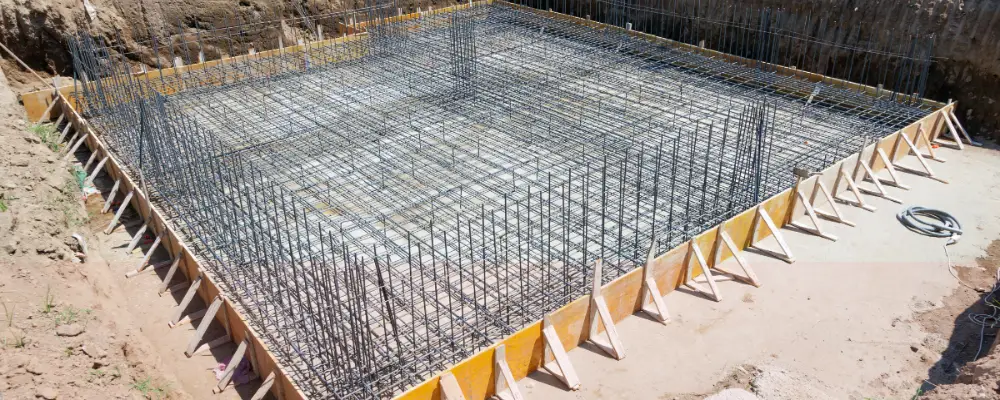A strong foundation is a bedrock for any construction project. The stability of the overall structure depends on the load-bearing capacity of the foundation. However, it is primarily affected by the settlement of the foundation, caused by many significant factors. They include poor compaction of the soil, low bearing capacity of the soil, etc.
These troubles can be efficiently handled by floating foundations. It is used in a wide range of construction projects, from small-scale to large-scale architecture, where there is a need to distribute the loads.
In this blog, you will see in detail about floating foundations, their principles, construction process, and advantages. Continue your reading to gain a better understanding of the whole topic:
What is a Floating Foundation?
A floating foundation is a type of foundation that plays a vital role in various construction projects. In this type, the total weight of the structure is approximately equal to the weight of the water and soil excavated from the construction site.
This method efficiently balances the weight and prevents excessive settlement of the structure. It is primarily used in areas where weak, compressible soils are unsuitable to carry significant loads. Importantly, the drainage, electrical lines, and plumbing works should be carried out before pouring the foundation, as these are typically running through the floor.
Principle of Floating Foundation
The primary principle of a floating foundation is to balance the weight of excavated soil with the structure of the same weight. This foundation method is also called a balanced raft foundation, which causes zero settlement to the structure.
Let’s imagine a ground with a water table and planning to construct a building on it. Currently, the ground is excavated below the water table, and a building is constructed with a foundation that matches the weight of the removed soil and water. The weight will be balanced here, and no changes can occur.
However, you need to make a note of this point, you can’t start constructing a building immediately after an excavation. Due to the depth of excavation, it may cause vertical pressure and create unbalanced weight while constructing. Therefore, we used to call this type of foundation a partly compensated foundation rather than a compensated or fully floating foundation.
Advantages of Floating Foundation
Floating foundations, also named as balancing rafts, possess several advantages, including:
Reducing Settlement: By balancing the weight of soil and water removed with the weight of the structure, reduce the differential settlement. It improves structural integrity and prevents the occurrence of cracks and uneven floors.
Self-leveling: Constructing a structure in weak soil is quite complex. To provide a stable base on the uneven ground, the floating foundation is used. It makes the foundation strong, and the weight is evenly distributed over a larger area, reducing the pressure on the soil.
Adaptability to Extension: This method is also efficiently suitable for existing buildings. You can easily extend the structures without causing any impacts to the existing foundations, and the loads can be evenly distributed.
Fight Against Water Seepage: Water seepage causes severe damage to the structures. It is quite possible in areas with high groundwater levels. This floating foundation acts as a barrier and protects the building from moisture damage.
Disadvantages of Floating Foundation
Here are the lists of significant disadvantages associated with floating foundations:
- This foundation method requires accurate calculation and careful consideration to maintain the balancing principle.
- Compared to other types of foundations, it is likely to be expensive and may not be suitable for structures with budget constraints.
- It is quite complex to maintain the utilities beneath the foundation.
- It may be subjected to soil movement, especially in expansive clay soil. They cause concrete to lose strength, resulting in cracks and structural inability.
- Floating foundations are not suitable for high seismic zones.
- Modification or construction expansion can be challenging; it might disturb the delicate balance of the foundation.
Construction Process of Floating Foundation
Site investigation: Before beginning any construction project, the soil condition should be investigated to determine its moisture content, bearing capacity, and other significant properties. This helps design the foundation’s dimensions and reinforcement appropriate to the soil condition and structural loads.
Site Excavation: Excavation is the initial preparation process. As per the planned depth, the weight of the removed soil and water needs to be balanced with the weight of the constructed structure. To prevent any damage, sheet piles or other supportive methods can be used.
Gravel Base for Foundation: Before the construction process, the drainage should be planned on the sides and bottom of the foundation. By laying a gravel base, the water can be easily drained out.
Reinforcement: The foundation of a building can be a reinforced concrete slab or a box-shaped structure. Reinforcement bars are placed within a formwork to improve the structural integrity of a building.
Backfilling: The excavated area and its surroundings should be backfilled with suitable material to ensure stability and prevent water absorption.
Challenges Faced During Construction of Floating Foundation
The construction of floating construction includes several challenges, such as:
- Accurate determination of soil properties, including compressibility, bearing capacity, and water content, is essential to prevent foundation failures and design errors.
- Balancing the excavation stability in soft soil is quite challenging.
- If the structure requires a dewatering operation, which is costly and time-consuming.
- It is difficult to ensure the concrete placement and curing in a confined space.
- Handling differential settlement is critical; it may affect the structural integrity of the building.
- Changes in the groundwater levels can significantly influence the foundation’s performance.
Final Wordings
Floating foundations can accommodate the changes in water levels and cause no damage to the structures. If you are planning to construct a building in wet soils, then consider a floating foundation as your primary choice. It can efficiently handle clay and high groundwater pressures. Ensuring soil type and bearing capacity helps determine the foundation properties accurately.

